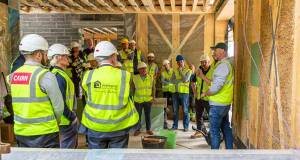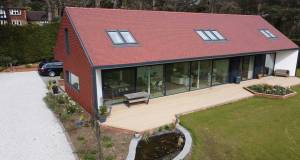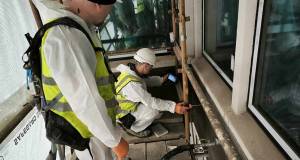
- Marketplace
- Posted
Ecological welcomes new internal insulation guidance
This article was originally published in issue 40 of Passive House Plus magazine. Want immediate access to all back issues and exclusive extra content? Click here to subscribe for as little as €10, or click here to receive the next issue free of charge
The guidance provides advice on how to undertake such upgrades without creating a moisture or fire risk, while safeguarding indoor air quality.
“It is encouraging from the outset that the document refers to a term we regularly use when referring to appropriate solutions for retrofit — moisture open,” said Neil Turner, technical sales manager with Ecological Building Systems. “The document emphasises the benefits of vapour diffusion open insulating materials and of ensuring full contact between the insulation and the internal face of the wall with no still air gaps. It also outlines the need to avoid unventilated air gaps and of using, in certain cases, Intelligent airtightness membranes and lime plaster finishes as opposed to vapour barriers.
“It also states that dynamic hygrothermal modelling (using software such as WUFI or Delphin) in accordance with EN15026 should be carried out in order to assess the potential for moisture risks with any proposed upgrade.”
The new guidance document highlights that for the insulation to function as designed, the risk of air convection induced thermal bypass must be addressed by ensuring an airtight building. For enhancing indoor air quality sufficient mechanical ventilation should be employed.
The document also explains the required measures to be taken on the external side of the wall (rainwater goods, water pooling at the ground, pointing of the external masonry etc.), as well the importance of workmanship and the use of trained installers and builders.
Ecological Building Systems has provided extensive training and technical solutions with a range of vapour diffusion open insulation and airtightness products for almost two decades, which are in line with the new BEIS guidelines for internal wall insulation.
These solutions include pro clima Intelligent membranes, Diasen lime thermal plaster, Calsitherm climate boards and Gutex woodfibre. Ecological Building Systems also works closely with architects and specifiers (including WUFI moisture calculations and thermal bridge modelling) and is actively involved in training contractors in the installation of these products.
Turner concluded: “In conclusion I believe that the new guidance document is a highly valuable addition in terms of assisting the construction industry to design, to specify and implement internal wall insulation retrofit, and help our industry to achieve the goal of reduced carbon emissions, reduced energy use, and improved thermal comfort combined with good indoor air quality, whilst at the same time eliminating the risk of moisture issues.”
Related items
-
 New Ejot profile cuts thermal bridging losses by 25mm insulation equivalent
New Ejot profile cuts thermal bridging losses by 25mm insulation equivalent -
 Build Homes Better updates Isoquick certification to tackle brick support challenge
Build Homes Better updates Isoquick certification to tackle brick support challenge -
 Ecological Building Systems expands UK and Irish straw panel construction with EcoCocon deal
Ecological Building Systems expands UK and Irish straw panel construction with EcoCocon deal -
 Focus on better buildings, not better spreadsheets
Focus on better buildings, not better spreadsheets -
 MBC offers total passive house envelope solutions
MBC offers total passive house envelope solutions -
 Historic Dublin building retrofitted with cutting edge insulation
Historic Dublin building retrofitted with cutting edge insulation


